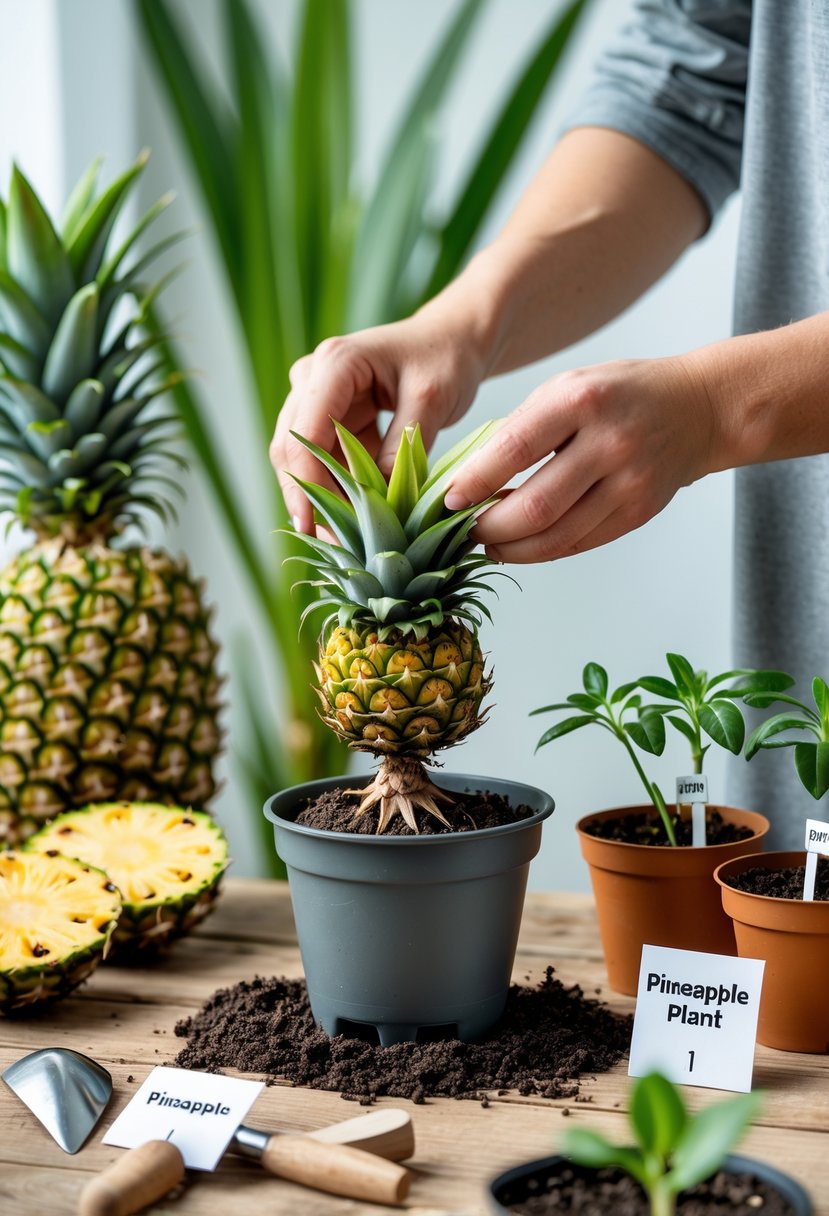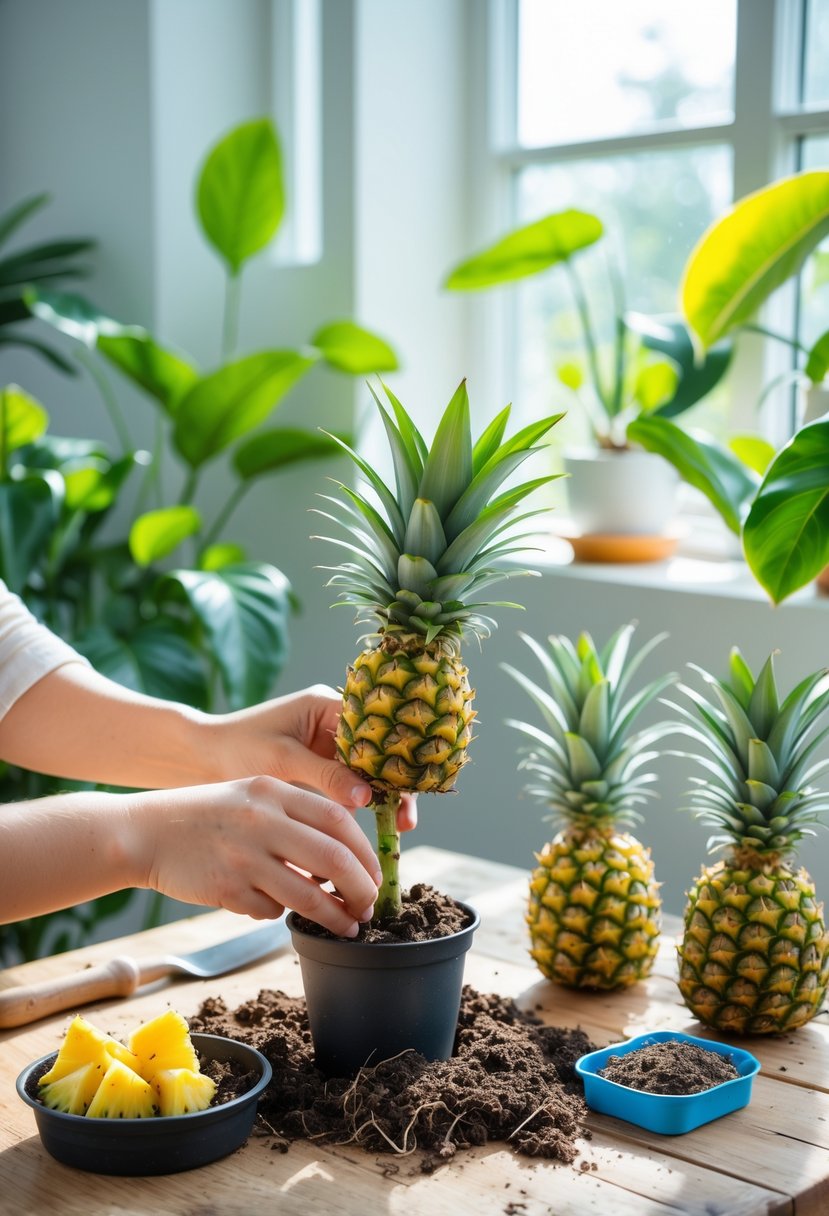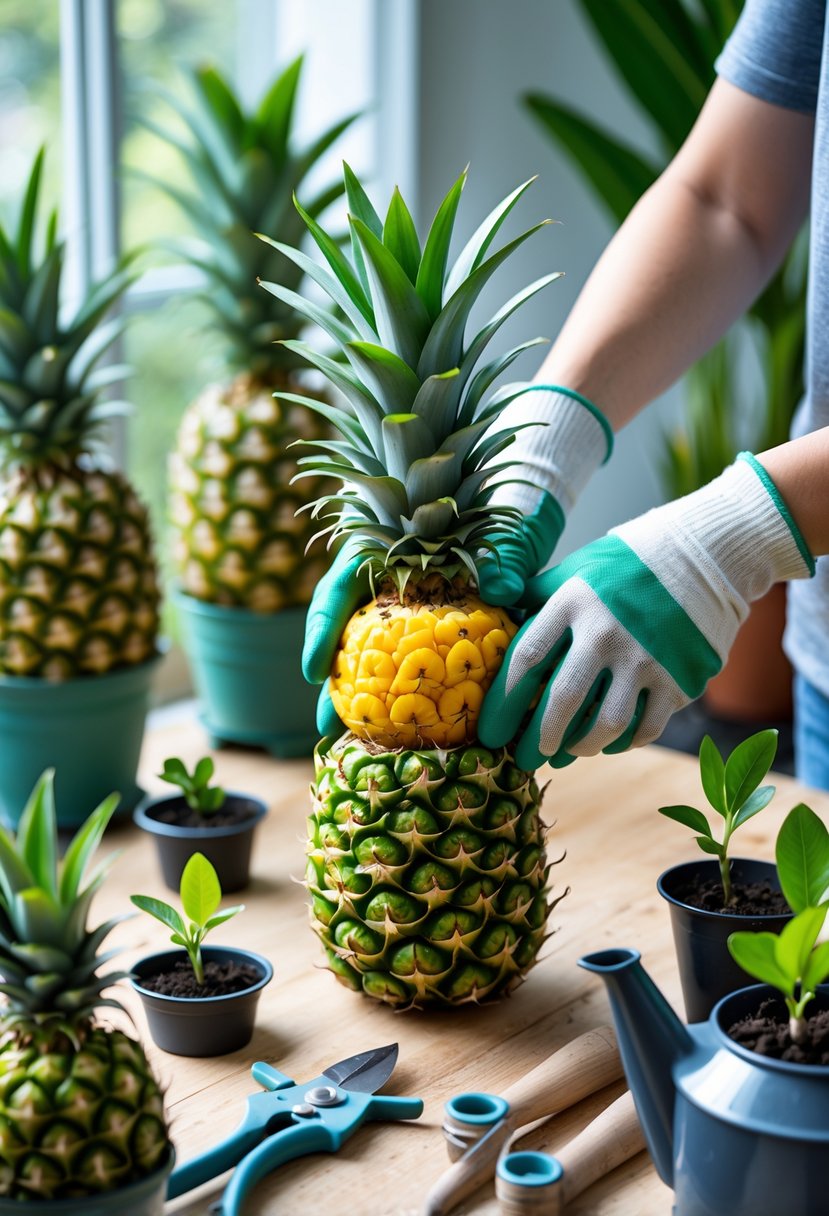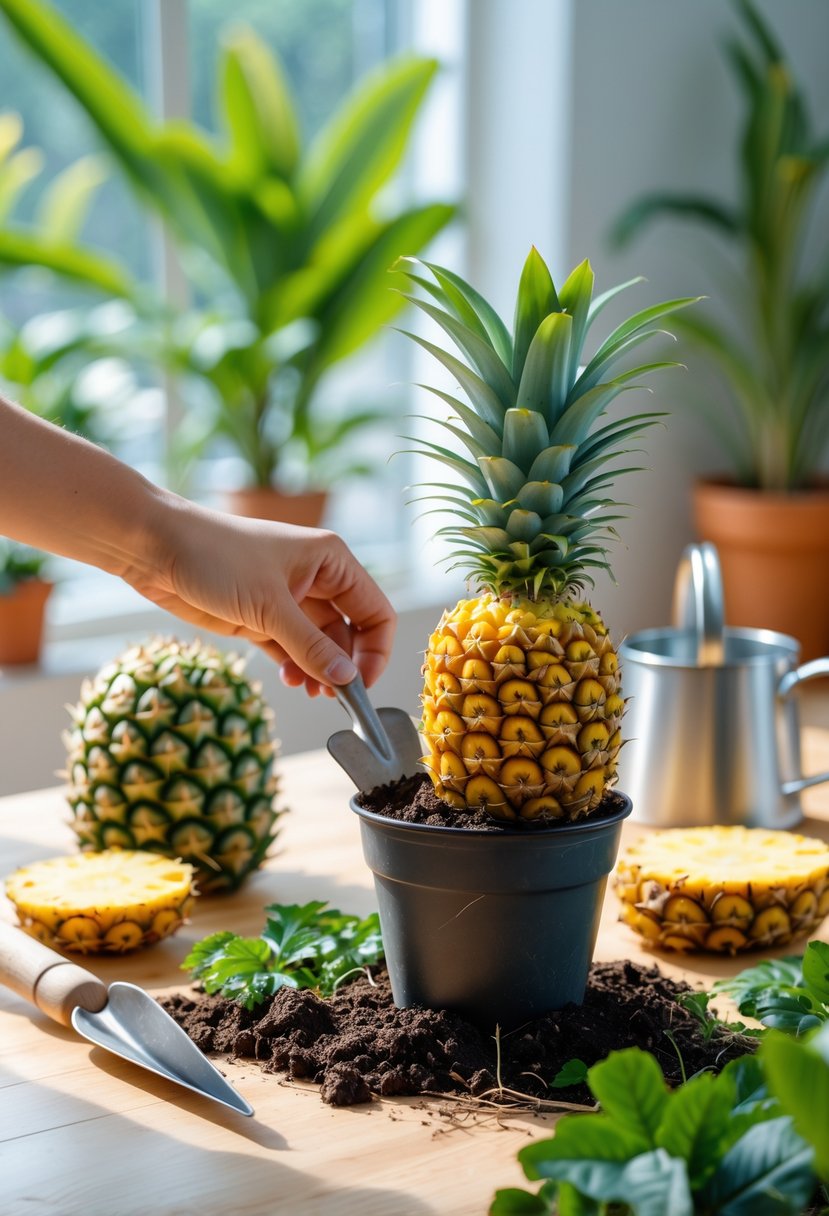Many people think growing pineapples at home is hard, but it is actually a simple and fun process. Pineapples do not grow on trees—they grow from leafy crowns, and almost anyone can grow them in a pot or garden with the right steps. Home gardeners can enjoy fresh, homegrown pineapples by following clear and easy instructions.

Growing your own pineapple plant does not require much space, and the plant adds a tropical touch to any home or garden. Even if it takes patience for the fruit to grow, the results are worth it. With just a store-bought pineapple, some basic supplies, and care, anyone can start their own pineapple-growing journey today.
Step-By-Step Guide to Growing Pineapples at Home

Growing pineapples at home is simple but does require the right conditions, good care, and patience. Each step, from picking the right fruit to caring for the plant, helps ensure healthy growth and the chance of producing fruit.
Selecting a Healthy Pineapple
Choosing the right pineapple is the first important step. A healthy pineapple will have bright green leaves, no mold near the base, and a firm, golden-yellow body. Avoid pineapples with brown, dry, or wilted leaves as these may not root well.
Check for soft spots or signs of rot, especially near the base of the leaves. A fresh, sweet smell at the bottom of the fruit usually means good quality. It is best to pick a pineapple that is ripe but not overripe.
Healthy, robust leaves are a sign the crown is suitable for growing. This increases the chances of successful root development. Always wash the pineapple to remove any chemicals or pests before starting the next step.
Preparing the Pineapple Crown
Cutting or twisting off the crown (leafy top) must be done carefully to avoid damaging the growth point. Use a sharp, clean knife to remove the top, leaving about one inch of fruit attached.
Remove a few of the bottom leaves to expose the stem. This step helps roots grow easily. Let the crown dry out for 1–2 days in a shady, cool spot.
Allowing the crown to dry reduces the risk of rot and fungus. It is important not to skip this drying stage. Avoid placing it in full sun or damp areas while drying.
Prepare your materials before moving to the next stage: clean water, a glass, and a warm, bright spot.

Rooting the Crown for Optimal Growth
Place the dried pineapple crown in a glass of water. Only the exposed stem (not the leaves) should touch the water. Set the glass in a bright place, such as a warm windowsill.
Change the water every 2–3 days to keep it clean and prevent bacteria growth. Roots may start appearing after 1–3 weeks, sometimes a little longer.
Once roots are about 2 inches long, the crown is ready for planting. If there is no root growth after several weeks, check for signs of rot and try again with a fresh crown.
Rooting in water helps you watch the rooting process, but it is also possible to root the crown directly in soil. Keep the environment humid by misting the leaves with clean water if the air is dry.
Planting in Well-Draining Soil
Select a small pot (6–8 inches across) with drainage holes to avoid waterlogging. Fill it with a well-draining soil mix. A good option is equal parts potting soil, sand, and perlite or small bark chips.
Make a hole in the center of the soil deep enough for the roots. Gently place the rooted crown in the hole and cover the roots. Press the soil down lightly to secure the plant.
Water the soil lightly to settle it around the roots. Avoid overwatering at this stage. If planting outdoors, pick a location with rich, loose soil and good drainage.
Pineapples grow well when their roots are not sitting in wet soil, so drainage is key for a healthy pineapple plant.
Watering and Sunlight Requirements
Pineapples prefer bright, indirect sunlight for at least 6–8 hours each day. A sunny window, porch, or sheltered outdoor spot works well.
Water the plant when the top one inch of soil feels dry to the touch. Pineapple plants do not like soggy soil. Overwatering can cause root rot, while underwatering may stunt growth.
Misting the leaves sometimes helps, especially in dry climates. During cooler months, water less often.
Quick Watering Tips:
- Use room temperature water
- Drain any excess water from saucers or trays
- Do not let soil stay continuously wet
A proper sunlight and watering routine encourages new leaf growth and prepares the plant for fruit development.
Applying Balanced Fertilizer
Pineapple plants benefit from a balanced, all-purpose fertilizer. Look for fertilizer with equal amounts of nitrogen (N), phosphorus (P), and potassium (K).
Feed the plant every 2–3 months during the growing season. Liquid fertilizers or slow-release pellets are both good options.
Apply fertilizer to the soil, not directly onto the plant’s crown. Rinse the soil with plain water once in a while to prevent salt build-up.
You can also use organic options, such as compost tea or worm castings, for a more natural approach. Fertilizer boosts leaf growth and overall plant health, which supports future fruiting.
Patience and Fruit Development
Pineapples are slow-growing. It may take 18–24 months for the plant to produce fruit, sometimes even longer in cooler climates.
During this period, keep caring for the plant as described above. Watch for a flower spike forming in the center of the leaves—this signals fruit development will soon begin.
The new pineapple fruit will grow gradually at the top of the plant. Continue regular care, ensuring the plant receives plenty of sunlight, proper watering, and light feeding.
Fruit matures over several months. When the skin is golden and the fruit smells sweet, it is ready to harvest. Each plant generally produces one fruit, but shoots (called “pups”) at the base can be planted to start the cycle again.
Care and Maintenance Tips

Pineapple plants need the right light, watering habits, and protection from pests. Healthy growing conditions help avoid issues like root rot and wasting time on common mistakes.
Indoor vs Outdoor Growing
Indoor Pineapples: Indoors, pineapple plants need at least 6–8 hours of bright light every day. South-facing windows or grow lights work well. Temperatures should stay between 65°F and 85°F. Avoid cold drafts and don’t place plants near air vents.
Outdoor Pineapples: Outside, they do best in warm, frost-free climates. A spot with full sun is important, and shelter from strong winds protects the leaves. If there’s risk of frost, bring the plant inside or cover it.
Watering: Whether indoors or outdoors, soil should be well-draining. Water only when the top inch of soil feels dry. Avoid letting the pot sit in water to prevent root rot.
Temperature Table
| Location | Ideal Temp | Light Needed |
|---|---|---|
| Indoor | 65-85°F (18-29°C) | 6-8 hours, bright |
| Outdoor | 65-95°F (18-35°C) | Full sunlight |
Dealing with Pests and Root Rot
Pineapple plants can face pests such as mealybugs, scale insects, and spider mites. Check leaves regularly for tiny insects or sticky residue. Remove pests using a damp cloth or mild soapy water. Avoid harsh chemicals, especially on indoor plants.
Root rot is a major concern. It happens when soil stays wet for too long. Always plant pineapples in well-draining soil. Use pots with drainage holes, and do not overwater. If leaves turn yellow or mushy, check the roots for rot. Remove any rotting parts and replant in fresh, dry soil.
Good air circulation and clean pots help keep the plant healthy. Keep the plant spaced away from others to allow airflow.
Common Mistakes to Avoid
- Overwatering: The most common mistake is watering too often. Pineapple plants do not like soggy soil.
- Poor soil choice: Dense or heavy soil leads to standing water and root rot. Use a loose, sandy, or cactus potting mix.
- Not enough light: Without enough sunlight, growth slows and fruiting won’t happen. Use supplemental light indoors if needed.
- Neglecting pot size: As the pineapple plant grows, it needs repotting into a bigger container for healthy root development.
- Ignoring temperature drops: Exposure to cold can damage the plant. Always protect from frost or sudden chills.
- Skipping pest checks: Pests spread quickly. Regular inspections prevent problems before they start.
Harvesting and Propagating More Pineapple Plants

Pineapples are unique tropical plants that can produce fruit at home with careful attention. Knowing when to pick pineapples, how to use parts of the plant for new growth, and how to encourage more fruit are essential for successful harvests and future crops.
Recognizing When to Harvest
A pineapple is ready to harvest when its skin turns from green to yellow, especially at the base. This change means the fruit has fully ripened on the plant. Ripe pineapples also have a sweet, fruity smell at the base.
It is best to harvest the pineapple in the morning, using a sharp knife or pruning shears. Cut the fruit from the stalk, leaving about an inch of stem on the bottom. Gloves are recommended since the leaves are sharp.
Sometimes, the fruit may not turn completely yellow. In this case, look for a sweet aroma and slight softness when pressing gently. Harvesting at the right time helps ensure the best flavor and texture.
Propagating from Pups, Slips, and Crowns
Pineapple plants create new baby plants called pups, slips, and crowns. Pups grow between the leaves at the base of the plant. Slips are smaller shoots that form underneath the fruit. Crowns are the leafy tops of the harvested fruit.
Each part can be used to grow a new plant:
- Pups: Gently pull from the main plant once they are about 6 inches tall.
- Slips: Snap off when they look mature or around 3-6 inches long.
- Crown: Twist or cut off, remove extra fruit flesh, and peel a few lower leaves.
Let each piece dry for 1-2 days before planting. Place them in well-draining soil, water lightly, and keep them in a warm spot. Good care helps these new plants root and grow strong.
Encouraging Flowering and Additional Fruiting
After the first harvest, pineapple plants can produce more fruit if managed well. Removing old suckers and leaving 1-2 healthy ones helps the plant focus on new growth. Use a balanced fertilizer high in nitrogen and potassium to boost flowering.
Regular watering without over-wetting the soil is important. Some gardeners use fruit, like an apple, placed close to the plant to release natural ethylene gas. This gas encourages the pineapple to flower sooner.
Keep the plant in a warm, bright place with indirect sunlight. Once flowers appear, fruit will form in several months, allowing continued pineapple harvests at home.
Frequently Asked Questions

Growing pineapples at home involves choosing the right environment, understanding the propagation method, and caring for the plant over a long period. Success depends on following correct steps for planting, soil preparation, watering, and pest management.
What are the essential conditions required for growing pineapples at home?
Pineapples need warm temperatures and plenty of sunlight. At least 6 to 8 hours of direct sunlight daily is best. The area should be sheltered from strong wind and not prone to frost. Consistent warmth and light help the plant grow well.
Can you explain the propagation process for pineapples from a store-bought fruit?
Start by twisting or cutting off the leafy crown from a ripe pineapple. Remove some lower leaves to expose the stem. Allow it to dry for a day. Then plant the crown in moist, well-draining soil, with the stem just under the surface. Keep the soil damp but not soggy while roots begin to grow.
How much time does it take for a pineapple plant to produce fruit?
A pineapple plant usually takes 18 to 24 months to produce fruit. Growth is slow, and the plant may need over a year before flowering starts. Patience is important because the waiting period cannot be rushed.
What type of soil and fertilizer is ideal for healthy pineapple growth?
Pineapples prefer well-draining, sandy loam or potting soil. The soil should not hold excess water, which can cause root rot. Using a balanced fertilizer or one high in potassium every 2 to 3 months supports strong growth and fruit development.
How do you care for a pineapple plant to ensure successful fruiting?
Water the pineapple regularly to keep the soil moist but not wet. Place the plant in a bright, warm spot. Remove dead leaves and check for pests. Fertilize as needed. If growing in a container, ensure it has good drainage to prevent waterlogging.
What are common pests or problems when growing pineapples and how can they be addressed?
Mealybugs and scale insects can attack pineapple plants. Inspect leaves often and remove pests with a damp cloth or use insecticidal soap. Overwatering can cause root rot, so ensure the soil drains well. Yellowing leaves may indicate too much water or poor soil drainage.

